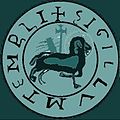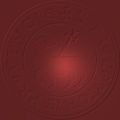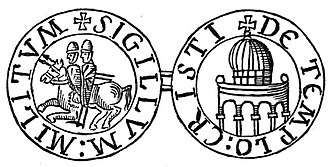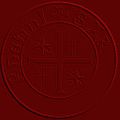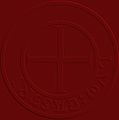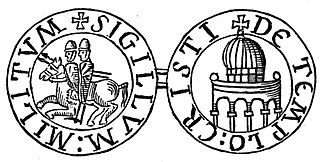
The Poor Fellow-Soldiers of Christ and of the Temple of Solomon, also known as the Order of Solomon's Temple, the Knights Templar or simply the Templars, were a Catholic military order founded in 1119, headquartered on the Temple Mount in Jerusalem through 1128 when they went to meet with Pope Honorius II. They were recognized in 1139 by the papal bull Omne datum optimum. The order was active until 1312 when it was perpetually suppressed by Pope Clement V by the bull Vox in excelso.

Hugues de Payens or Payns was the co-founder and first Grand Master of the Knights Templar. In association with Bernard of Clairvaux, he created the Latin Rule, the code of behavior for the Order.

The Equestrian Order of the Holy Sepulchre of Jerusalem, also called Order of the Holy Sepulchre or Knights of the Holy Sepulchre, is a Catholic order of knighthood under the protection of the Holy See. The pope is the sovereign of the order which, with the five other papal equestrian orders and the Sovereign Military Order of Malta, are the only orders of chivalry that are recognised and protected by the Holy See.

The Sovereign Military Order of the Temple of Jerusalem,, is a self-styled order and international NGO. In 2020 it was recognized by the Augustan Society as a religious confraternity of knights. OSMTH is often referred to simply as the Knights Templars but asserts no direct lineage to the original Order. OSMTH does not officially recognize the claims laid out in the Larmenius Charter as historically valid, but makes a moral and ethical claim to follow in the same spiritual path as the original Order of the Knights Templar. OSMTH, which is open to Christians of any denomination, operates as a charity.

Arnold of Torroja was a knight of Crown of Aragon and the ninth Grand Master of the Knights Templar from 1181 until his death in 1184.

The Militia Templi, also called the Order of the poor Knights of Christ, is a lay order of the Roman Catholic Church.

Godfrey of Saint-Omer was a Flemish knight and one of the founding members of the Knights Templar in 1119.
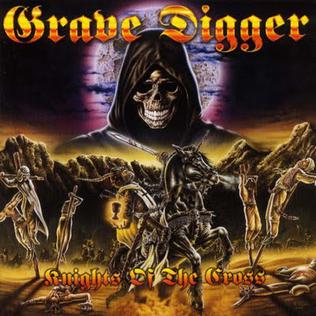
Knights of the Cross is the eighth studio album by German heavy metal band Grave Digger, released in 1998. It is the second album of the Middle Ages Trilogy.
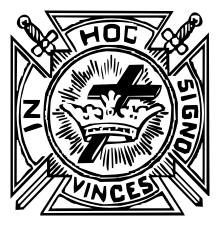
The Knights Templar, full name The United Religious, Military and Masonic Orders of the Temple and of St John of Jerusalem, Palestine, Rhodes and Malta, is a fraternal order affiliated with Freemasonry. Unlike the initial degrees conferred in a regular Masonic Lodge, which only require a belief in a Supreme Being regardless of religious affiliation, the Knights Templar is one of several additional Masonic Orders in which membership is open only to Freemasons who profess a belief in Christianity. One of the obligations entrants to the order are required to declare is to protect and defend the Christian faith. The word "United" in its full title indicates that more than one historical tradition and more than one actual order are jointly controlled within this system. The individual orders 'united' within this system are principally the Knights of the Temple, the Knights of Malta, the Knights of St Paul, and only within the York Rite, the Knights of the Red Cross.

There are Masonic degrees named after the Knights Templar but not all Knights Templar Orders are Masonic.

Renaud (Reginald) de Vichiers was the 19th Grand Master of the Knights Templar from 1250 to 1256.

Temple is a village and civil parish in Midlothian, Scotland. Situated to the south of Edinburgh, the village lies on the east bank of the river South Esk.
The original historic Knights Templar were a Christian military order, the Order of the Poor Fellow Soldiers of Christ and of the Temple of Solomon, that existed from the 12th to 14th centuries to provide warriors in the Crusades. These men were famous in the high and late Middle Ages, but the Order was disbanded very suddenly by King Philip IV of France, who took action against the Templars in order to avoid repaying his own financial debts. He accused them of heresy, ordered the arrest of all Templars within his realm, put the Order under trial and many of them burned at the stake. The dramatic and rapid end of the Order led to many stories and legends developing about them over the following centuries. The Order and its members increasingly appear in modern fiction, though most of these references portray the medieval organization inaccurately.

The Templum Domini was the name attributed by the Crusaders to the Dome of the Rock in Jerusalem. It became an important symbol of Jerusalem, depicted on coins minted under the Christian Kingdom of Jerusalem.
The Latin Rule was a document with 72 clauses attributed to Bernard de Clairvaux and Hugues de Payens. It is also known as the "Specific Behavior for the Templar Order". It outlines the ideal behavior of a knight.
The history of the Knights Templar in England began when the French nobleman Hughes de Payens, the founder and Grand Master of the order of the Knights Templar, visited the country in 1128 to raise men and money for the Crusades.

The flag and coat of arms of the Sovereign Military Order of Malta display a white cross on a red field, ultimately derived from the design worn by the Knights Hospitaller during the Crusades.


